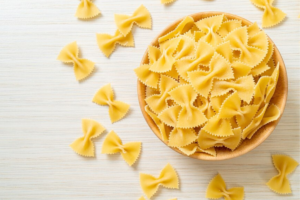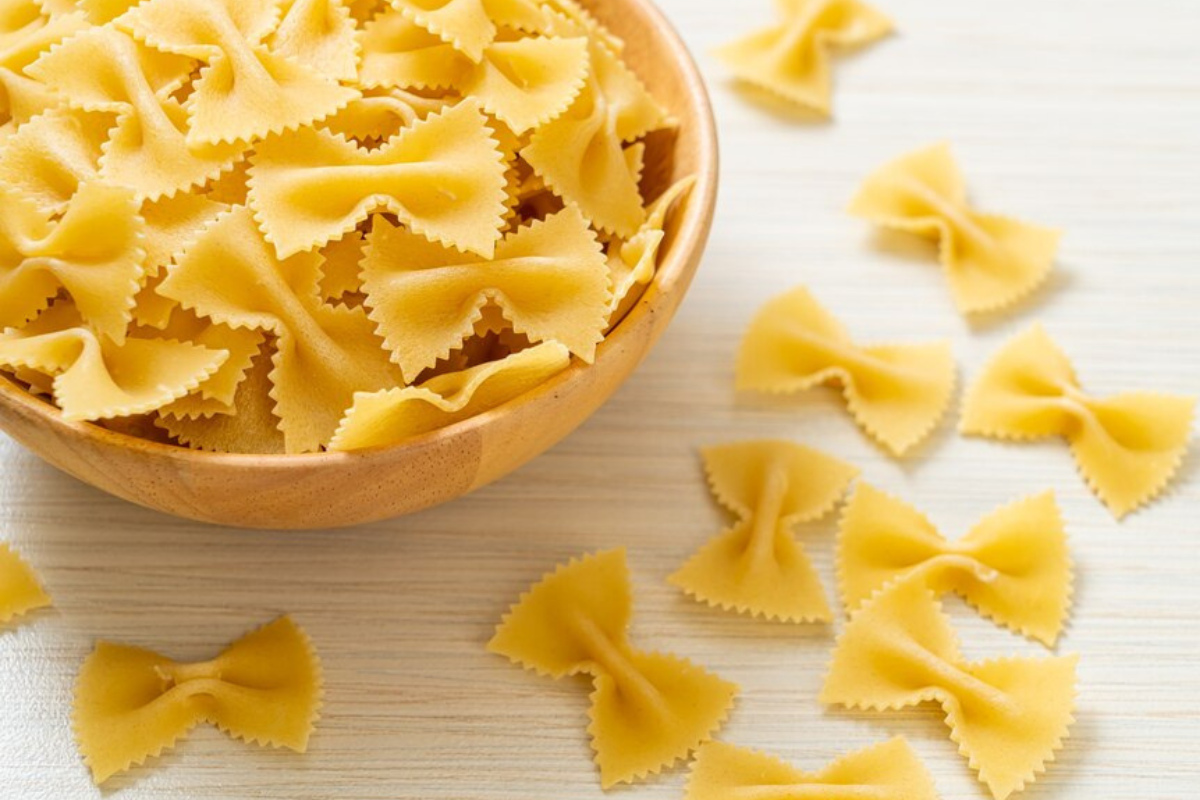Cooking bow tie pasta (also known as farfalle) is a common task in kitchens around the world. However, achieving that perfect al dente texture requires more than just tossing pasta into boiling water. One of the most frequently asked questions is: “How much water do you need to cook bow tie pasta properly?” The answer is crucial because the right water-to-pasta ratio ensures that your pasta cooks evenly, doesn’t stick together, and retains its flavor.
In this comprehensive guide, we’ll dive deep into the importance of water in pasta cooking, provide a detailed step-by-step process for cooking bow tie pasta, and discuss common mistakes to avoid. By the end, you’ll be equipped with the knowledge to cook perfect bow tie pasta every time, ensuring your dishes are always a success.
Introduction to Bow Tie Pasta.
Bow tie pasta is a versatile pasta shape that is popular for a wide variety of dishes. Its unique shape allows it to hold onto sauces well, making it ideal for everything from light pasta salads to rich, creamy dishes. However, to get the most out of bow tie pasta, it’s important to understand the basics of cooking it correctly.
The Importance of Water in Cooking Pasta.
Water is a critical element when it comes to cooking pasta. The amount of water you use influences how evenly the pasta cooks, prevents it from sticking together, and ensures that the pasta has the right texture.
For bow tie pasta, the general rule is to use 1 quart (4 cups) of water per 4 ounces of pasta. This amount of water allows the pasta to move freely in the pot, which is essential for even cooking. If you don’t use enough water, the pasta can become sticky and unevenly cooked. Conversely, too much water can dilute the pasta’s flavor.
Understanding this ratio is crucial for achieving that perfect texture, and it’s a step you shouldn’t skip if you want your pasta to turn out just right. For more details on why water is so important in pasta cooking, consider reading How Do You Keep Bow Tie Pasta from Sticking Together?.
How Much Water Do You Need for Bow Tie Pasta ?

The amount of water you use is one of the most important factors in cooking bow tie pasta correctly. Here’s the recommended water-to-pasta ratio:
- 1 quart (4 cups) of water per 4 ounces of pasta
- 1 gallon (16 cups) of water for a full pound of pasta
This ratio ensures that the pasta has enough room to cook without clumping together. If you’re preparing more pasta, simply increase the amount of water accordingly. Using enough water is essential because it prevents the pasta from sticking together and ensures it cooks evenly, resulting in a perfect al dente texture.
Step-by-Step Guide .
To cook bow tie pasta perfectly, follow these steps:
- Boil the Water
Start by filling a large pot with the recommended amount of water. Place the pot on the stove and bring the water to a rolling boil over high heat. The boiling process should be vigorous enough to keep the pasta moving around in the pot. - Add Salt
Once the water is boiling, add salt. A good rule of thumb is 1-2 tablespoons of salt per pound of pasta. Salt not only enhances the flavor of the pasta but also helps it cook evenly. It’s an essential step that shouldn’t be overlooked. - Add the Pasta
After the salt has dissolved, add the bow tie pasta to the boiling water. Stir the pasta immediately to prevent it from sticking together. Stirring is particularly important in the first few minutes of cooking. - Cook Time
Let the pasta cook according to the package instructions, usually around 10-12 minutes for an al dente texture. Al dente means “to the tooth,” referring to pasta that is firm to the bite. - Testing for Doneness
About 2 minutes before the recommended cooking time, start testing the pasta for doneness. The pasta should be firm but not hard, with a slight bite in the center. - Drain the Pasta
Once the pasta is cooked to your liking, drain it using a colander. Avoid rinsing the pasta unless your recipe specifically calls for it, as rinsing removes the starch that helps sauces cling to the pasta.
For more recipe ideas that utilize bow tie pasta, consider exploring Bow Tie Pasta Salad Recipes, Tips, and Variations for some delicious and creative dishes.
Common Mistakes to Avoid When Cooking Bow Tie Pasta .
Even experienced cooks can make mistakes when preparing pasta. Here are some common pitfalls to avoid:
- Using Too Little Water
Not using enough water can cause the pasta to cook unevenly and stick together. The pasta needs room to move around in the pot, so always use the recommended water-to-pasta ratio. - Not Stirring the Pasta
Stirring the pasta occasionally during cooking helps prevent it from sticking to the pot or clumping together. This is especially important during the first few minutes of cooking, as the pasta begins to release starch. - Overcooking the Pasta
Overcooking bow tie pasta can lead to a mushy texture that is less enjoyable to eat. To achieve an al dente result, keep a close eye on the cooking time and start testing the pasta a few minutes before the package’s recommended cooking time.
Perfecting the Al Dente Texture.
The term al dente is often used in pasta recipes, and it refers to pasta that is firm to the bite. This texture is ideal because it holds up well in dishes and provides a satisfying chew. Here’s how to achieve the perfect al dente texture:
- Start testing the pasta 2 minutes before the recommended cooking time on the package.
- The pasta should be firm but not hard when you bite into it, with a slight resistance in the center.
- If you prefer a softer texture, cook the pasta for an additional minute or two, but be careful not to overcook it.
Recipes That Highlight Bow Tie Pasta.
Bow tie pasta is incredibly versatile and can be used in a variety of dishes. Here are a few recipe ideas that showcase its adaptability:
- Creamy Bow Tie Pasta with Garlic and Parmesan
This rich and satisfying dish is perfect for pairing with proteins like chicken or shrimp. The creamy sauce clings beautifully to the bow tie pasta, making for a comforting meal. - Pasta Salad with Vegetables and Vinaigrette
A light and refreshing option that’s perfect for summer picnics or as a side dish. The shape of the bow tie pasta allows it to hold the vinaigrette and vegetables, providing a flavorful and balanced bite. - Tomato Basil Bow Tie Pasta
A simple yet flavorful dish that highlights the freshness of tomatoes and basil. This dish is quick to prepare, making it ideal for weeknights when you need a delicious meal in a hurry.
For more insights into what makes bow tie pasta special, you can explore What Is Bow Tie Pasta Made Of?, which discusses the ingredients and variations of this popular pasta type.
How to Store and Reheat Cooked Bow Tie Pasta
Proper storage and reheating are key to maintaining the texture and flavor of your bow tie pasta. Here’s how you can do it:
Storing Cooked Pasta:
- After cooking, allow the pasta to cool slightly before transferring it to an airtight container.
- Store the pasta in the refrigerator, where it will keep for 3-5 days. Proper storage ensures that the pasta retains its texture and doesn’t become too dry or mushy.
Reheating Pasta:
- To reheat, place the pasta in a pot of boiling water for about 30 seconds, or microwave it with a bit of water to prevent drying out. The addition of water helps to maintain the pasta’s moisture and prevents it from becoming overly dry.
- Adding a bit of olive oil or sauce to the pasta before reheating can also help maintain the texture and prevent it from sticking together.
FAQs: Common Questions About Cooking Bow Tie Pasta
Here are some frequently asked questions about cooking bow tie pasta:
- How much salt should I add to the water?
The general recommendation is 1-2 tablespoons of salt per pound of pasta. This not only enhances the flavor of the pasta but also helps to prevent it from becoming too sticky during cooking. - Do I need to rinse bow tie pasta after cooking?
Typically, no. Rinsing pasta removes the starch that helps sauces cling to the pasta. However, if you’re making a cold pasta salad, rinsing can help cool the pasta quickly and prevent sticking. - Can I cook bow tie pasta without a lid on the pot?
Yes, you can cook pasta without a lid, but it may take slightly longer to reach a boil. Cooking without a lid allows steam to escape, which helps prevent the water from boiling over. - How can I prevent bow tie pasta from sticking together?
Stirring the pasta occasionally during cooking and using plenty of water will help prevent sticking. If you’re still having trouble with the pasta sticking, try adding a little olive oil to the water, though this is generally unnecessary if you stir the pasta properly.
Conclusion: Mastering Bow Tie Pasta
Cooking bow tie pasta to perfection is all about understanding the importance of the water ratio and following the right steps. By adhering to the guidelines outlined in this article, you can ensure that your pasta turns out perfect every time, whether you’re preparing a simple weeknight dinner or a more elaborate dish for guests.
Remember, the key to great pasta lies in the details using the right amount of water, seasoning the water properly, and avoiding common cooking mistakes. With a bit of practice and attention to these principles, you’ll be able to create delicious bow tie pasta dishes that are sure to impress.
For more pasta cooking tips and recipe ideas, consider exploring related articles like Bow Tie Pasta Salad Recipes, Tips, and Variations or How Do You Keep Bow Tie Pasta from Sticking Together?. These resources will help you expand your pasta repertoire and elevate your cooking skills.

